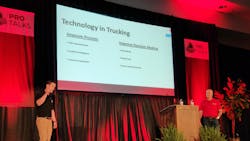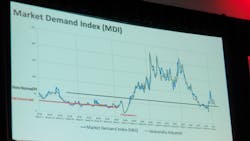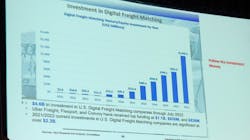LOUISVILLE, Kentucky—Soft spot rates are causing concern for owner-operators, who often rely heavily on the spot market. In light of these financial worries, load board operator Truckstop's Chief Relationship Offer Brent Hutto advised carriers on how they can negotiate the best rates from brokers.
An extra 10 cents per mile per load, Hutto said, is an extra $10,000 annually for a truck running 100,000 miles per year.
Despite difficult market conditions, Hutto, during a session at the Mid-America Trucking Show last week, emphasized the cyclical nature of the freight market, encouraging motor carriers to stay in the game, as he sees opportunity in the future. Additionally, he said that, according to Truckstop data, what are perceived as low freight volumes can more accurately be described as a return to normal after freight volumes spiked in 2020 and 2021 during the coronavirus-prompted increases in consumer spending.
“I know it’s a tough market right now,” Hutto said. “I know that fuel is a little bit of a challenge, especially for small owner-operators. I know that inflation hits all of us. But it’s still a normal market when it comes to the amount of freight that’s in the marketplace. It’s just correcting back to normal.”
Companies have invested an exponentially increasing amount of capital into digital freight matching. While 2011 saw only $2 million invested in the software area, 2022 saw over $1.4 billion invested. Companies would not be investing if they did not see opportunity for growth, Hutto pointed out.
The automation of driving has been long-promised, but Hutto said current drivers need not worry about that. The automation of information, however, is here, and continues to accelerate. For example, using AI, brokers can already read a shipper’s purchase order and create a load for the load board automatically, Tyler Johnston, freight operations manager at Mercer Transportation (No. 68 on the FleetOwner 500 For-Hire), said. Carriers and owner-operators are suggested loads based on historical data. As these tools continue to be refined and become easier to use, a larger percentage of freight could land on the spot market, increasing opportunity for those who wish to take it.
Negotiating the brokers: Don't define the problem, define the solution
Brokers want to be spoken to the way most people want to be spoken to: Politely and directly, Johnston advised. Johnston has a list of what he calls “wall-builders”—commonly heard phrases from carriers that taint their relationships with brokers.
What to avoid saying to a broker
- “That rate is cheap.”
- “What’s your best rate?”
- “Can you do more?”
Johnston advised carriers against saying that someone else has a better rate. If a carrier wants a better rate, Johnston said, that carrier should indicate why it offers a better service than competitors.
If a driver is close to a load—for example, 100 miles—that is information the broker didn’t know that, when shared, could be used to negotiate a better rate.
If a load is to be run on what is a dedicated lane for a carrier, that is information that could be used to negotiate a better rate, as well as potentially setting up more consistent freight movement along that lane with that broker.
“Use me as a tool,” Johnston said. “Maybe I can ask the customer for a load that’s similar to the one that you’re seeing on the load board. If you see a [load going from] Chicago to Atlanta and you’re really in Indianapolis, and you’re willing to bounce to Chicago for a Georgia load, maybe I have something outside Indianapolis that fits you better, and you don’t even see it.”
Information equals leverage
The more information a carrier has, the better it will be able to assess what is a fair rate for a particular load, according to Johnston and Hutto.
“If there’s more of something moving, usually there’s a capacity shortage in it. You can get a better rate,” Hutto said.
Dean Croke, principal analyst of trucking research group and load board operator DAT Freight & Analytics, told attendees in another panel to “be a student of what you haul.”
There is often data that would be of interest to drivers wishing to forecast favorable rates. For example, Croke said, produce season in the Southeast starts in mid-April, meaning rates can increase by as much as 20 cents per mile until July. For drivers looking to haul construction materials, the U.S. Census Bureau regularly publishes the number of building permits that have been applied for, usually a few months ahead of construction, allowing drivers to see if construction—and therefore the movement of construction materials—is trending up or down in a given region.
Chad Bobblet, an owner-operator who runs the Rate Per Mile Masters group on Facebook, said in a separate MATS session that he monitors freight volumes and always tries to go to a market with more freight moving out than going in, as a broker can charge lower rates as he exits that market.
Bobblet also advises fostering relationships by creating an email list in which drivers can notify carriers they regularly work with where they are and what they are looking for.
About the Author
Scott Keith
Scott Keith is a former fleet owner digital editor, who was on staff from 2022 to 2023.



